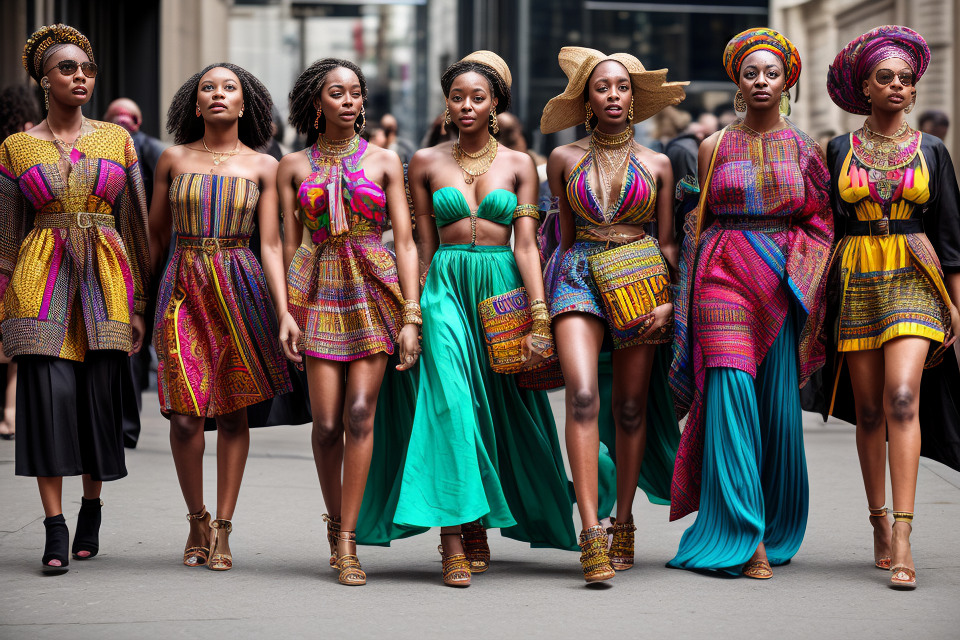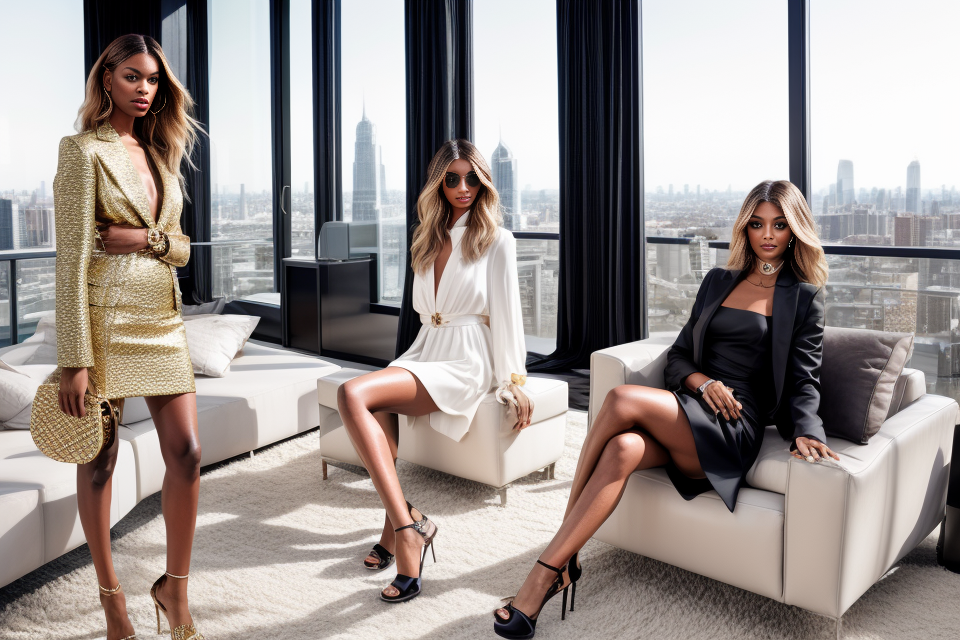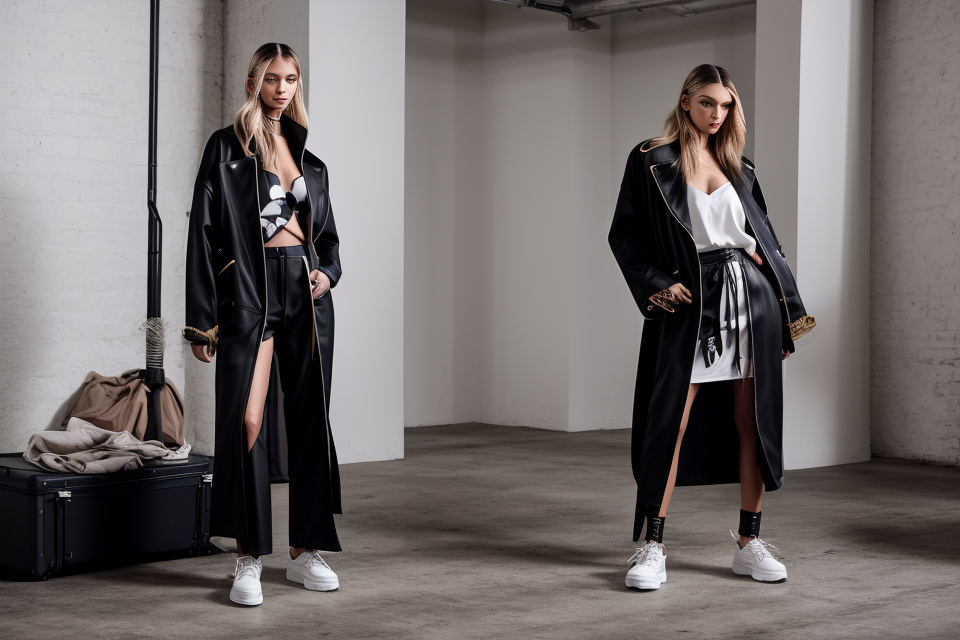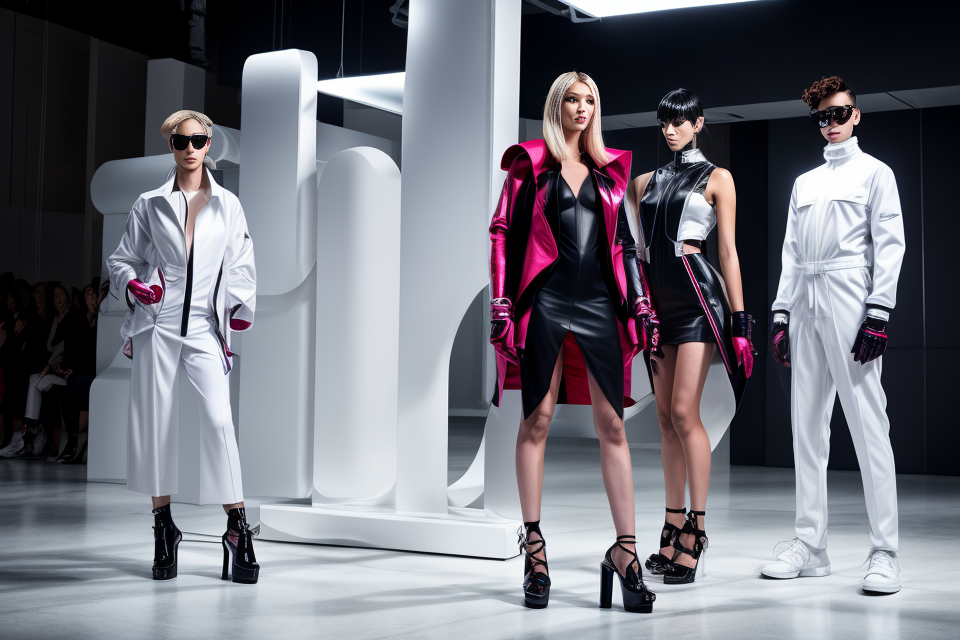
Fashion is an ever-evolving world that never fails to inspire us. It’s a form of self-expression that reflects our personality and style. With the vast number of sources available, finding inspiration for your wardrobe can be a daunting task. However, fear not! This article will guide you through the four most diverse sources of fashion inspiration that will help you to stand out from the crowd. From street style to social media, we’ll explore the endless possibilities that fashion has to offer. So, get ready to unleash your creativity and discover the world of fashion inspiration!
The Evolution of Fashion Inspiration
Historical Eras
The Roaring Twenties
The Roaring Twenties, also known as the Jazz Age, was a time of great change and liberation in fashion. This era was marked by the rise of the flapper, a new type of woman who rejected traditional gender roles and embraced her independence. Flappers were known for their short haircuts, bobbed dresses, and heavy use of makeup. They also favored bright, bold colors and daring, asymmetrical styles. The fashion of the Roaring Twenties was all about expressing individuality and breaking free from societal norms.
The Great Depression
The Great Depression had a profound impact on fashion, as people struggled to make ends meet in a time of economic hardship. Clothing became more practical and functional, with people focusing on durability and versatility. Many women turned to sewing their own clothes, using patterns and fabrics that were readily available. The fashion of the Great Depression was characterized by simple, utilitarian styles that could be easily adapted to fit different occasions.
The Post-War Era
The post-war era saw a shift in fashion as people began to focus on optimism and positivity after years of hardship. The 1950s brought about a new level of glamour and sophistication, with designers such as Christian Dior leading the way. Dior’s “New Look” revolutionized fashion by introducing full skirts, small waists, and elaborate details. The fashion of the post-war era was all about creating a sense of elegance and luxury.
The Swinging Sixties
The 1960s was a time of social and cultural revolution, and fashion was no exception. The “Swinging Sixties” brought about a new level of youth culture and rebellion, with young people rejecting the conservative styles of their parents. The fashion of the 1960s was all about experimentation and self-expression, with designers such as Mary Quant leading the way. The decade saw the rise of the miniskirt, the bohemian look, and the use of bold, bright colors and patterns. The fashion of the 1960s was a reflection of the changing times, as people embraced a more liberal and open-minded approach to life.
Cultural and Artistic Movements
Fashion inspiration has evolved over time, and it has been influenced by various cultural and artistic movements. These movements have left an indelible mark on the fashion industry, and they continue to inspire designers and fashion enthusiasts today. In this section, we will explore the impact of cultural and artistic movements on fashion inspiration.
Art Nouveau
Art Nouveau was an artistic movement that emerged in the late 19th century and flourished until the early 20th century. It was characterized by its organic and fluid lines, which were inspired by nature. The movement had a significant impact on fashion, particularly in the area of graphic design. Designers incorporated Art Nouveau elements into their fashion designs, such as using floral patterns and curves in their garments.
Art Deco
Art Deco emerged in the 1920s and 1930s and was characterized by its bold geometric shapes and bright colors. The movement had a significant impact on fashion, particularly in the area of jewelry and accessories. Designers incorporated Art Deco elements into their designs, such as using diamonds, platinum, and gold in their jewelry.
Pop Art
Pop Art emerged in the mid-1950s and was characterized by its use of popular culture imagery, such as advertising and comic books. The movement had a significant impact on fashion, particularly in the area of print and pattern design. Designers incorporated Pop Art elements into their designs, such as using bold and bright colors and graphic prints.
Street Art
Street Art emerged in the 1970s and 1980s and was characterized by its use of urban and graffiti imagery. The movement had a significant impact on fashion, particularly in the area of graphic design and sportswear. Designers incorporated Street Art elements into their designs, such as using bold and bright colors, graffiti prints, and sportswear silhouettes.
In conclusion, cultural and artistic movements have played a significant role in shaping fashion inspiration over time. Designers have incorporated elements from these movements into their designs, creating unique and innovative styles that have left a lasting impact on the fashion industry.
Fashion Inspiration from Nature
Flora and Fauna
Fashion designers have long been inspired by the beauty and intricacy of nature, particularly in the realms of flora and fauna. These natural elements have been incorporated into clothing and accessories for centuries, and continue to be a popular source of inspiration for designers today.
Botanical Patterns
Botanical patterns have been a popular fashion trend for many years, with designers incorporating everything from delicate floral motifs to bold leaf prints into their collections. These patterns can be found in a variety of different styles, from elegant evening wear to casual streetwear.
One of the key advantages of using botanical patterns in fashion is their ability to evoke a sense of natural beauty and grace. The intricate shapes and colors of flowers and leaves can add a touch of sophistication to even the simplest of outfits, making them perfect for special occasions or everyday wear.
In addition to their aesthetic appeal, botanical patterns also have a certain timeless quality that makes them a popular choice for fashion designers. Whether you prefer classic floral prints or more modern geometric patterns, there is a botanical pattern to suit every taste and style.
Animal Prints
Animal prints have been a staple of fashion for decades, with designers incorporating everything from zebra stripes to leopard spots into their collections. These prints are often associated with boldness and strength, making them a popular choice for those looking to make a statement with their fashion choices.
One of the key advantages of animal prints is their versatility. They can be paired with a variety of different styles and colors, making them a great choice for those who want to add a pop of personality to their wardrobe. Whether you prefer a bold leopard print dress or a more subtle cheetah print top, there is an animal print to suit every taste and occasion.
In addition to their versatility, animal prints also have a certain timeless quality that makes them a popular choice for fashion designers. Whether you prefer classic black and white stripes or more modern colorblocked prints, there is an animal print to suit every taste and style.
Earthy Tones and Textures
When it comes to fashion inspiration from nature, earthy tones and textures play a significant role in creating a natural and organic look. Here are some of the key earthy tones and textures that designers and fashion enthusiasts can draw inspiration from:
Mineral Shades
Mineral shades are a group of earthy tones that are inspired by the colors of the earth and minerals. These colors include shades of beige, brown, and taupe, which can be found in rocks, soil, and sand. Designers can incorporate these colors into their designs to create a natural and grounded look.
For example, a dress in a soft beige shade with delicate brown and taupe patterns can evoke a sense of warmth and comfort, reminiscent of a cozy blanket or a sun-kissed rock. The use of mineral shades can also create a sense of stability and reliability, which can be particularly appealing in times of uncertainty.
Organic Materials
Organic materials are another source of inspiration for earthy tones and textures in fashion. These materials include fabrics made from natural fibers such as cotton, linen, silk, and wool. Natural fibers have unique textures and patterns that can add depth and interest to a design.
For instance, a blouse made from soft linen with intricate texture can create a casual yet sophisticated look, while a dress made from delicate silk chiffon with a subtle texture can exude elegance and refinement. The use of organic materials can also create a sense of connection to nature, which can be particularly appealing to consumers who value sustainability and environmental consciousness.
In conclusion, earthy tones and textures can be a rich source of inspiration for fashion designers and enthusiasts. By incorporating mineral shades and organic materials into their designs, they can create a natural and organic look that evokes a sense of warmth, stability, and connection to nature.
Fashion Inspiration from Technology and Science
Futuristic Materials
In recent years, fashion designers have been increasingly turning to technology and science for inspiration. One of the key areas where this has been most evident is in the use of futuristic materials. These materials are not only innovative and cutting-edge, but they also offer a wide range of possibilities for designers looking to push the boundaries of fashion.
Metals and Plastics
Metals and plastics have long been used in fashion, but they are now being used in new and innovative ways. For example, designers are experimenting with using 3D printing to create intricate and unique metal and plastic pieces that can be incorporated into clothing and accessories. This technology allows for a level of customization and precision that was previously impossible, opening up new possibilities for designers.
Smart Textiles
Smart textiles are another area where technology and fashion intersect. These are textiles that have been designed to respond to changes in temperature, light, or other environmental factors. For example, a smart jacket might be able to adjust its insulation based on the weather, or a pair of smart pants might be able to detect when you’re sitting down and adjust their fit accordingly. This technology has the potential to revolutionize the way we think about clothing, making it more functional and responsive to our needs.
Overall, the use of futuristic materials in fashion is an exciting development that offers a wide range of possibilities for designers. Whether it’s through the use of metals and plastics, or the integration of smart textiles, these materials are helping to push the boundaries of what is possible in fashion, and are sure to continue to play a major role in the industry in the years to come.
Biometric Design
Biometric design in fashion refers to the integration of technology into clothing and accessories to enhance comfort, fit, and functionality. This innovative approach to fashion design has led to the development of body-adaptive clothing and comfortable footwear.
Body-Adaptive Clothing
Body-adaptive clothing is designed to conform to the contours of the body, providing a personalized fit and enhanced comfort. This technology is achieved through the use of smart materials, such as shape-memory alloys and elastomeric fibers, which can change shape and flexibility in response to body temperature and movement.
One example of body-adaptive clothing is the “Smart Shirt,” a garment that can monitor the wearer’s heart rate, breathing, and posture in real-time. The shirt contains sensors embedded in the fabric that collect data and transmit it to a mobile app, allowing the wearer to track their vital signs and receive feedback on their posture and movement.
Comfortable Footwear
Comfortable footwear is another area where biometric design has made significant strides. Many footwear companies are now incorporating advanced materials and technologies to create shoes that provide unparalleled support, cushioning, and stability.
For example, Adidas has developed a line of shoes called “Boost” that feature a proprietary cushioning system made from thousands of tiny plastic pellets. The pellets are compressed upon impact, providing superior shock absorption and energy return, reducing fatigue and injury.
Other companies, such as Under Armour and New Balance, have incorporated GPS tracking and motion sensors into their shoes, allowing runners and athletes to monitor their pace, distance, and performance in real-time.
Overall, biometric design is transforming the fashion industry by integrating technology into clothing and accessories to enhance comfort, fit, and functionality. As technology continues to advance, we can expect to see even more innovative designs and products that push the boundaries of fashion and design.
Fashion Inspiration from Global Cultures
Traditional Dress
- Ethnic Patterns
- Cultural Symbols
Ethnic Patterns
Ethnic patterns are a significant source of inspiration for fashion designers, drawing from various cultures around the world. These patterns are often characterized by intricate designs, vibrant colors, and unique motifs that reflect the cultural identity of the people who wear them. Some of the most popular ethnic patterns in fashion include:
- African wax prints: Also known as “Ankara” prints, these vibrant fabrics are a staple of African fashion. Originating from the Netherlands, they feature bold colors and geometric shapes that have become synonymous with African style.
- Asian florals: Inspired by traditional Asian art and textiles, these patterns often feature delicate flowers, leaves, and vines in a variety of colors. Popular styles include Japanese cherry blossoms, Chinese peonies, and Indian paisleys.
- Native American geometric designs: Drawing from the geometric designs of Navajo, Hopi, and other Native American tribes, these patterns often incorporate simple shapes like circles, squares, and triangles, arranged in bold and striking configurations.
Cultural Symbols
In addition to ethnic patterns, cultural symbols also play a significant role in fashion inspiration. These symbols are often rich in meaning and history, representing the values, beliefs, and traditions of the cultures they come from. Some of the most popular cultural symbols in fashion include:
- Celtic knots: These intricate, interwoven patterns have been a symbol of Irish culture for centuries. They represent the cyclical nature of life and the interconnectedness of all things.
- Chinese calligraphy: This ancient art form features elegant brushstrokes and bold characters that have become a popular design element in fashion. They represent the rich history and cultural heritage of China.
- African Adinkra symbols: These symbolic designs originate from the Ashanti people of Ghana and represent various concepts like strength, wisdom, and prosperity. They are often used in traditional fabrics and jewelry.
By incorporating ethnic patterns and cultural symbols into their designs, fashion designers can create unique and meaningful collections that celebrate the diversity and richness of global cultures.
Modern Urban Style
Modern urban style is a type of fashion that originated in urban areas and has been heavily influenced by various subcultures. It is characterized by a mix of edgy, casual, and street-inspired elements.
Streetwear
Streetwear is a subgenre of modern urban style that originated in the streets and has been heavily influenced by sportswear and hip-hop culture. It is characterized by oversized clothing, bold graphics, and a mix of high-end and street-inspired elements.
- Key Pieces: Hoodies, sneakers, baseball caps, oversized t-shirts, denim jackets
- Materials: Cotton, denim, nylon, mesh
- Colors: Black, white, gray, navy, red
City Chic
City chic is a subgenre of modern urban style that is characterized by a mix of classic and contemporary elements. It is often seen as a more polished and put-together version of streetwear.
- Key Pieces: Blazers, tailored trousers, heels, dresses, handbags
- Materials: Wool, silk, leather, cotton
- Colors: Black, white, navy, olive green, camel
Both streetwear and city chic are popular subgenres of modern urban style that have gained popularity in recent years. They offer a fresh and edgy take on fashion that is perfect for those who want to stay on-trend without sacrificing comfort or style.
The Impact of Social Media on Fashion Inspiration
Influencers and Trendsetters
Fashion influencers and trendsetters have emerged as a significant force in shaping the fashion industry. With the rise of social media platforms like Instagram, these individuals have gained immense popularity and have become powerful figures in the realm of fashion. They are no longer just fashion icons but also play a critical role in the fashion marketing ecosystem.
Fashion bloggers are one of the primary influencers who have carved a niche for themselves in the world of fashion. They share their personal style, outfit ideas, and fashion trends through their blogs, attracting a loyal following of readers who seek inspiration for their own wardrobes. Many fashion bloggers have leveraged their online presence to collaborate with fashion brands and become ambassadors for their products.
Instagram celebrities, on the other hand, have emerged as a force to be reckoned with in the fashion industry. These individuals have amassed a massive following on the photo-sharing app, making them highly sought after by fashion brands. They often have a significant impact on fashion trends, as their followers look to them for inspiration and guidance on what to wear. They are also frequently invited to fashion shows and events, further solidifying their status as fashion influencers.
Furthermore, influencers and trendsetters have become a critical component of fashion marketing strategies. Brands collaborate with them to promote their products, creating a buzz around their collections. This collaboration not only helps brands reach a wider audience but also provides influencers with a platform to showcase their personal style and influence fashion trends.
In conclusion, influencers and trendsetters have emerged as a crucial force in the fashion industry. Their online presence and massive following have given them the power to shape fashion trends and influence consumer behavior. They have become an integral part of the fashion marketing ecosystem, making them an indispensable asset for fashion brands looking to stay ahead of the curve.
Crowdsourced Design
- Online Contests
- Fashion brands are increasingly using online contests to crowdsource design ideas from a wide range of designers and enthusiasts.
- These contests provide an opportunity for emerging designers to showcase their talents and gain exposure, while also enabling established brands to tap into new and innovative design concepts.
- Participants submit their designs based on specific themes or challenges set by the brand, and a panel of judges selects the winning designs.
- The winning designs are often produced and sold by the brand, with the designer receiving recognition and a monetary prize.
- Collaborative Projects
- Collaborative projects involve partnering with a crowd of designers to co-create a product or collection.
- This approach allows brands to harness the creativity and diversity of a large group of designers, resulting in unique and fresh designs.
- Collaborative projects can take various forms, such as co-designing a single product or working together on a complete collection.
- These projects often involve an open call for designers to submit their designs, which are then reviewed and selected by the brand.
- The resulting designs are often sold under a shared label or brand, with profits distributed among the participating designers.
In both cases, crowdsourced design enables fashion brands to tap into a vast pool of creative talent and ideas, leading to more diverse and innovative designs. This approach also allows for greater engagement with customers and a more democratic approach to fashion design.
FAQs
1. What are the four sources of fashion inspiration?
There are numerous sources of fashion inspiration, but four primary sources stand out. These include nature, art, culture, and personal style. Each of these sources provides a unique perspective on fashion and can help individuals develop their own unique style.
2. How can nature be a source of fashion inspiration?
Nature offers a wealth of inspiration for fashion. For example, the colors and patterns found in flowers, leaves, and other natural elements can inspire the use of bold colors and intricate patterns in clothing. Additionally, the movement and flow of natural elements such as water and wind can inspire the use of draping and layering in fashion design.
3. How can art be a source of fashion inspiration?
Art can serve as a powerful source of inspiration for fashion. For example, the bold colors and abstract shapes found in abstract art can inspire the use of bright colors and bold shapes in clothing. Additionally, the intricate details found in art nouveau and art deco styles can inspire the use of intricate patterns and details in fashion design.
4. How can culture be a source of fashion inspiration?
Culture plays a significant role in fashion and can serve as a source of inspiration. For example, traditional clothing from different cultures can inspire the use of unique patterns, textures, and colors in fashion design. Additionally, the fashion choices of different cultures can inspire the use of different silhouettes and styles in fashion.
5. How can personal style be a source of fashion inspiration?
Personal style is unique to each individual and can serve as a powerful source of inspiration for fashion. By examining their own preferences, tastes, and lifestyle, individuals can develop a personal style that reflects their unique personality and preferences. Additionally, by paying attention to the fashion choices of others, individuals can gain inspiration for their own wardrobe and style.


